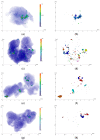Cell-Molecular Interactions of Nano- and Microparticles in Dental Implantology
- PMID: 36768589
- PMCID: PMC9916569
- DOI: 10.3390/ijms24032267
Cell-Molecular Interactions of Nano- and Microparticles in Dental Implantology
Abstract
The role of metallic nano- and microparticles in the development of inflammation has not yet been investigated. Soft tissue biopsy specimens of the bone bed taken during surgical revisions, as well as supernatants obtained from the surface of the orthopedic structures and dental implants (control), were examined. Investigations were performed using X-ray microtomography, X-ray fluorescence analysis, and scanning electron microscopy. Histological studies of the bone bed tissues were performed. Nanoscale and microscale metallic particles were identified as participants in the inflammatory process in tissues. Supernatants containing nanoscale particles were obtained from the surfaces of 20 units of new dental implants. Early and late apoptosis and necrosis of immunocompetent cells after co-culture and induction by lipopolysaccharide and human venous blood serum were studied in an experiment with staging on the THP-1 (human monocytic) cell line using visualizing cytometry. As a result, it was found that nano- and microparticles emitted from the surface of the oxide layer of medical devices impregnated soft tissue biopsy specimens. By using different methods to analyze the cell-molecule interactions of nano- and microparticles both from a clinical perspective and an experimental research perspective, the possibility of forming a chronic immunopathological endogenous inflammatory process with an autoimmune component in the tissues was revealed.
Keywords: X-ray fluorescence analysis (XRF); X-ray microtomography (XMCT); cytometry; dental implants; histological studies; immunopathological inflammation; microscale particles; scanning electron microscopy (SEM); soft tissue biopsy specimens; supernatants with nanoscale metallic particles (NSMP).
Conflict of interest statement
The authors declare no conflict of interest.
Figures


















Similar articles
-
Emission and Migration of Nanoscale Particles during Osseointegration and Disintegration of Dental Implants in the Clinic and Experiment and the Influence on Cytokine Production.Int J Mol Sci. 2023 Jun 2;24(11):9678. doi: 10.3390/ijms24119678. Int J Mol Sci. 2023. PMID: 37298627 Free PMC article.
-
Immunopathological Inflammation in the Evolution of Mucositis and Peri-Implantitis.Int J Mol Sci. 2022 Dec 13;23(24):15797. doi: 10.3390/ijms232415797. Int J Mol Sci. 2022. PMID: 36555457 Free PMC article.
-
Assessment of dental implant surface stability at the nanoscale level.Dent Mater. 2022 Jun;38(6):924-934. doi: 10.1016/j.dental.2022.03.003. Epub 2022 Mar 11. Dent Mater. 2022. PMID: 35289284
-
Oral mucosa tissue response to titanium cover screws.J Periodontol. 2012 Aug;83(8):973-80. doi: 10.1902/jop.2011.110392. Epub 2011 Dec 5. J Periodontol. 2012. PMID: 22141355
-
Cytotoxic effects of submicron- and nano-scale titanium debris released from dental implants: an integrative review.Clin Oral Investig. 2021 Apr;25(4):1627-1640. doi: 10.1007/s00784-021-03785-z. Epub 2021 Feb 22. Clin Oral Investig. 2021. PMID: 33616805 Review.
Cited by
-
Emission and Migration of Nanoscale Particles during Osseointegration and Disintegration of Dental Implants in the Clinic and Experiment and the Influence on Cytokine Production.Int J Mol Sci. 2023 Jun 2;24(11):9678. doi: 10.3390/ijms24119678. Int J Mol Sci. 2023. PMID: 37298627 Free PMC article.
References
MeSH terms
Substances
LinkOut - more resources
Full Text Sources
Research Materials

